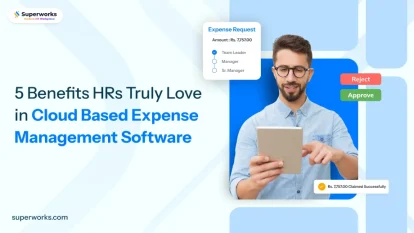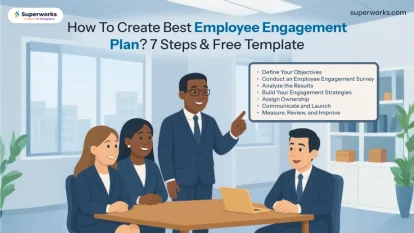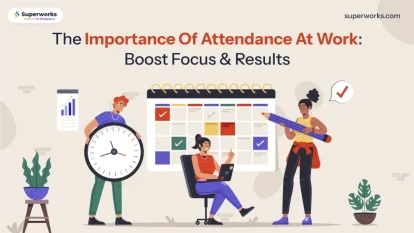
Introduction: Why Employment Engagement Matters
Employment engagement is vital for any organization’s success. It can affect productivity, job satisfaction and employee retention. It creates an environment that is emotionally involved in their jobs. Engaged employees don’t just show up. They make a difference, and they work with a an underlying purpose that creates value for their teams as well as the business. Engaging customers is directly connected to higher profits, improved customer satisfaction, and lower turnover rates.
It’s also not only focused on making employees satisfied. It’s about creating an environment where employees are connected to the mission of the company. They feel confident, are at ease, and view their job as being important. Companies that have solid engagement strategies are consistently better than their competition.
In this piece, we’ll discuss the most important components of engagement, effective workforce engagement methods, and ways you can develop a successful employee engagement plan that will benefit employees as well as the company in its entirety. We’ll also cover the importance of team engagement and how it supports organizational success.
What is Employment Engagement?
Employment engagement is more than job satisfaction; it’s the emotional, cognitive, and physical commitment employees have toward their work. Engaged employees are motivated by their connection to the company’s goals, pushing beyond mere task completion to deliver excellence. Engagement helps employees feel included and valued. They also feel engaged in the pursuit of organizational success.
Often, people confuse employee engagement with satisfaction. While satisfaction indicates the extent to which employees are happy working, engagement goes deeper and reveals how engaged they are in pushing the company ahead. The employees who are motivated work tirelessly because they believe in the mission of the company.
If you know what constitutes what is employee engagement in HR, engaging employees, it’s obvious that HR plays a major role in creating engagement. An effective employee engagement process programs, training, and reward mechanisms are the primary motivations for engagement.
Team engagements are also a critical component. Employees who perform well in groups are more likely to stay motivated because they experience a sense of belonging and a shared sense of success. If team members work well together and achieve shared goals, the entire team benefits.
Key Elements of Employment Engagement
There are many factors involved in creating high levels of involvement within the workplace:
Effective Communication: Clear and concise communication helps employees know what they are accountable for and how they can contribute towards the larger objectives of the business. This means periodic updates, creating transparent feedback mechanisms, as well as establishing confidence through consistent messaging.
Opportunities for Growth: grow professionally are more motivated. Training, career development sessions, mentoring employee engagement program. People employed by a firm will likely invest the money they earn into their jobs because they’re confident about their company’s future.
Recognition and Rewards: Recognizing the contributions of employees is an effective motivational factor for engagement. From simple thank-you notes to formal gifts or bonuses, recognition makes employees feel appreciated. Organizations that have efficient recognition programs typically have an extremely engaged workforce because employees feel valued for their hard work.
Work-Life Balance: Overworked employees are prone to burnout, which leads to disengagement. Flexible working hours respecting time for personal needs and fostering mental wellbeing all make a difference in ensuring long-lasting commitment.
Team Engagement: A strong Team engagement results in collective achievement. Employees who feel part of their team and are able to share common goals, stay engaged. Teams should be encouraged to work together and create environments in which collaboration flourishes.
Types Of Employee Engagement
There are three main types of employee engagement, each contributing to a well-rounded and motivated workforce:
Emotional Engagement: The employees feel emotionally involved in their jobs and with the business’s purpose. They are convinced that they have a stake in the company’s growth and they are more likely to remain for the long haul, adding value.
Cognitive Engagement: This type of engagement focuses on intellectual investment. The employees are committed mentally to their job, constantly seeking ways to improve and enhance productivity.
Physical Engagement: Employees who are physically engaged put extra energy into their work, going the extra mile when needed. They remain productive throughout the day and are willing to invest extra effort when required.
A successful staff engagement strategy should address all three types of engagement to maximize employee potential and overall organizational performance.
Increase Employment Engagement by 40% with Superworks HRMS solutions.
Join 200+ companies that increase employment satisfaction easily with us.
Strategies for Boosting Employment Engagement
To foster long-lasting engagement, companies need comprehensive employee engagement strategies. Here are some practical strategies you can implement in your company:
Create clear expectations and goals: Employees perform better when they are aware of their goals. The alignment of individual goals with corporate mission can help employees believe that their job is important and leads to increased satisfaction.
Provide Continuous Feedback: Regular feedback, both positive and constructive, helps employees grow and stay aligned with company goals. Check-ins, performance reviews, as well as open feedback channels, are vital elements of engaging employees effectively.
Offer Development Opportunities: Investing in employee development, through mentorship programs or training, keeps employees engaged and motivated. Work engagement emphasizes the importance of continual learning and growth opportunities to keep employees engaged.
Foster a Positive Workplace Culture: A supportive and inclusive work environment is crucial for high engagement. Employees who feel connected to their colleagues and the organization are more likely to stay engaged and perform well.
Recognition and Reward: Honoring the achievements of employees is a simple method to motivate them. Through public acknowledgment or through a reward system that encourages employees to remain focused on their work.
Encourage Autonomy: Employees who have control over how they complete their work are often more engaged. Giving employees autonomy lets them be more involved in their work and be more involved in the outcome.
Utilizing technology: Platforms that include the employee management system or a top HRMS, you can monitor employee performance, provide feedback, and enhance communications. They can simplify the process of engagement and give valuable information about the needs of employees.
The Role of Technology in Employment Engagement
Technology plays an important part in today’s methods of workforce engagement strategies for workers. Tools like HRMS platform and employee management systems help track engagement metrics, facilitate communication, and recognize achievements. With the help of technology, businesses can develop a more flexible process of engagement that can respond to the needs of employees immediately.
Furthermore, programs such as tools like the Employment Referral Program allow companies to get employees involved in the process of acquiring talent and create an atmosphere of responsibility and a sense of reward. Making clear communications through formal documents such as the Employment Offer Letter and the Employment Agreement, sets the stage for a respectful and positive relationship right beginning.
Measuring Employment Engagement
Regularly measuring engagement is crucial if you want to know how well your employee engagement methods are working. Here are a few methods:
Feedback from Employees on Satisfaction: Taking surveys can provide insight into what employees think about their jobs, company management, and culture. Surveys should be conducted anonymously for genuine feedback.
Performance Metrics: Monitoring performance along with attendance, productivity, as well as other performance indicators provides an insight into the engagement of employees. People who are more engaged are more productive as well as experience lower rates of absenteeism.
Low Turnover Rates: An engaged workforce is often associated with lower turnover. People who are happy and engaged tend to stay longer in the company, which reduces hiring and training expenses.
Feedback Systems: Setting up feedback channels, like feedback boxes, regular check-ins or suggestion boxes lets employees voice their concerns and suggestions, while also fostering a culture of continual improvement.
Sustaining Long-Term Employment Engagement
Engagement isn’t a once-off project; it is a continuous commitment. Here are a few strategies for ensuring long-term engagement:
Programming for Continuous Development: Providing continuous opportunities to develop keeps employees engaged through encouraging professional and personal advancement.
Work-Life Balance: Keeping an appropriate balance between work and life is crucial for a long-lasting involvement. Flexibility as well as mental health assistance can help workers avoid burning out.
Regularly scheduled feedback and adjustments: The strategies for engaging employees should be adapted to the organization. Feedback regularly ensures that the business stays responsive to employees’ needs.
Celebration of Milestones and Recognition: Recognizing the achievements of employees and other milestones like work anniversary celebrations helps keep employees enthusiastic and active.
Build Trust and Transparency: Trust is the cornerstone of engagement. Open communication about company goals and transparency in decision-making build trust, fostering a culture where employees feel valued.
Provide Opportunities for Team Engagement: Support collaborative efforts, team-building exercises, and cross-departmental projects that promote a feeling of community and mutual success.
Conclusion
The ability to sustain and build strong employment engagement is essential to the overall success of an organization. By focusing on the mental, emotional, as well as physical aspects of engagement businesses can build a highly motivated and productive staff.
Making use of modern technology such as HRMS platforms, Employment Verification Letter, and Employee Management Systems will streamline employee engagement and make it simpler to monitor progress and respond to the needs of employees in real time. Through continuous feedback, recognition, and transparency, organizations can build a thriving, productive work environment where employees feel valued and motivated to contribute their best.






